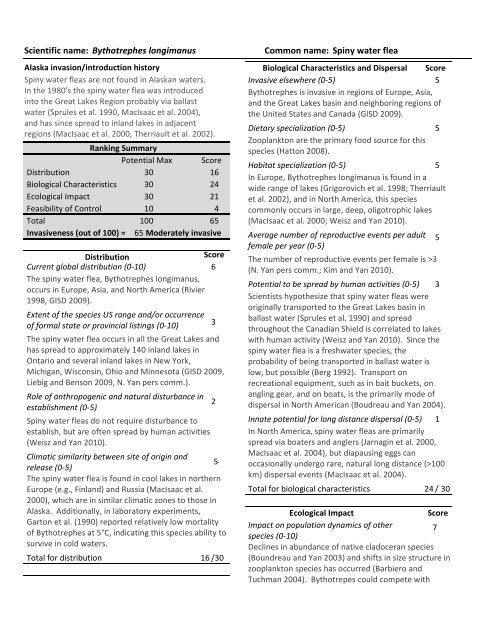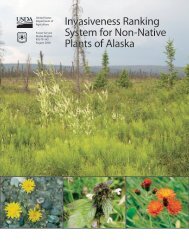Common name: Spiny water flea Scientific name - Alaska Natural ...
Common name: Spiny water flea Scientific name - Alaska Natural ...
Common name: Spiny water flea Scientific name - Alaska Natural ...
Create successful ePaper yourself
Turn your PDF publications into a flip-book with our unique Google optimized e-Paper software.
<strong>Scientific</strong> <strong>name</strong>: Bythotrephes longimanus<strong>Alaska</strong> invasion/introduction history<strong>Spiny</strong> <strong>water</strong> <strong>flea</strong>s are not found in <strong>Alaska</strong>n <strong>water</strong>s.In the 1980's the spiny <strong>water</strong> <strong>flea</strong> was introducedinto the Great Lakes Region probably via ballast<strong>water</strong> (Sprules et al. 1990, MacIsaac et al. 2004),and has since spread to inland lakes in adjacentregions (MacIsaac et al. 2000, Therriault et al. 2002).Ranking SummaryPotential Max ScoreDistribution 3016Biological Characteristics 3024Ecological Impact 3021Feasibility of Control 104Total 10065Invasiveness (out of 100) = 65 Moderately invasiveDistributionScoreCurrent global distribution (0‐10)6The spiny <strong>water</strong> <strong>flea</strong>, Bythotrephes longimanus,occurs in Europe, Asia, and North America (Rivier1998, GISD 2009).Extent of the species US range and/or occurrenceof formal state or provincial listings (0‐10)3The spiny <strong>water</strong> <strong>flea</strong> occurs in all the Great Lakes andhas spread to approximately 140 inland lakes inOntario and several inland lakes in New York,Michigan, Wisconsin, Ohio and Minnesota (GISD 2009,Liebig and Benson 2009, N. Yan pers comm.).Role of anthropogenic and natural disturbance in2establishment (0‐5)<strong>Spiny</strong> <strong>water</strong> <strong>flea</strong>s do not require disturbance toestablish, but are often spread by human activities(Weisz and Yan 2010).Climatic similarity between site of origin and5release (0‐5)The spiny <strong>water</strong> <strong>flea</strong> is found in cool lakes in northernEurope (e.g., Finland) and Russia (MacIsaac et al.2000), which are in similar climatic zones to those in<strong>Alaska</strong>. Additionally, in laboratory experiments,Garton et al. (1990) reported relatively low mortalityof Bythotrephes at 5°C, indicating this species ability tosurvive in cold <strong>water</strong>s.Total for distribution 16 / 30<strong>Common</strong> <strong>name</strong>: <strong>Spiny</strong> <strong>water</strong> <strong>flea</strong>Biological Characteristics and Dispersal ScoreInvasive elsewhere (0‐5)5Bythotrephes is invasive in regions of Europe, Asia,and the Great Lakes basin and neighboring regions ofthe United States and Canada (GISD 2009).Dietary specialization (0‐5)5Zooplankton are the primary food source for thisspecies (Hatton 2008).Habitat specialization (0‐5)5In Europe, Bythotrephes longimanus is found in awide range of lakes (Grigorovich et al. 1998; Therriaultet al. 2002), and in North America, this speciescommonly occurs in large, deep, oligotrophic lakes(MacIsaac et al. 2000; Weisz and Yan 2010).Average number of reproductive events per adult 5female per year (0‐5)The number of reproductive events per female is >3(N. Yan pers comm.; Kim and Yan 2010).Potential to be spread by human activities (0‐5) 3Scientists hypothesize that spiny <strong>water</strong> <strong>flea</strong>s wereoriginally transported to the Great Lakes basin inballast <strong>water</strong> (Sprules et al. 1990) and spreadthroughout the Canadian Shield is correlated to lakeswith human activity (Weisz and Yan 2010). Since thespiny <strong>water</strong> <strong>flea</strong> is a fresh<strong>water</strong> species, theprobability of being transported in ballast <strong>water</strong> islow, but possible (Berg 1992). Transport onrecreational equipment, such as in bait buckets, onangling gear, and on boats, is the primarily mode ofdispersal in North American (Boudreau and Yan 2004).Innate potential for long distance dispersal (0‐5) 1In North America, spiny <strong>water</strong> <strong>flea</strong>s are primarilyspread via boaters and anglers (Jarnagin et al. 2000,MacIsaac et al. 2004), but diapausing eggs canoccasionally undergo rare, natural long distance (>100km) dispersal events (MacIsaac et al. 2004).Total for biological characteristics 24 / 30Ecological ImpactScoreImpact on population dynamics of other 7species (0‐10)Declines in abundance of native cladoceran species(Boundreau and Yan 2003) and shifts in size structure inzooplankton species has occurred (Barbiero andTuchman 2004). Bythotrepes could compete with
<strong>Scientific</strong> <strong>name</strong>: Bythotrephes longimanusnative invertebrates and planktivorous fish for foodresources (Boudreau and Yan 2003, Foster and Sprules2009).The long caudal spine causes ingestion difficulties insmall fish (Schneeberger 1991, Baker et al. 1992, Millset al. 1992, Barnhisel and Harvey 1995), and candisrupt foraging behavior (Barnhisel and Kerfoot 2004).In small lakes,abundance and therefore impacts ofBythotrephes may be reduced by fish predation(Stenson 1972, Nilsson 1979).Impact on natural community composition (0‐710)The Great Lakes have experienced large declines inzooplankton species richness (16% decline in LakeErie, 28% decline in Lake Michigan) and shifts in sizestructure of zooplankton communities (Barbiero andTuchman 2004). More specifically, densities ofcladocera species have declined in many lakes(Boudreau and Yan 2003) and Bythotrephes hasconsumed more zooplankton than most otherpredatory invertebrates, resulting in a 300% highertotal consumption (Foster and Sprules 2009).Reductions in zooplankton abundance and biomasscan release phytoplankton from grazing pressure(Elser and Goldman 1991) and increase competitionamong small zooplanktivorous fish for reduced foodresources (Boudreau and Yan 2003). Rotifer densitiescould increased due to indirect impacts on food webs(Hovius et al. 2006).Impact on natural ecosystem processes (0‐10) 7Many lakes with spiny <strong>water</strong> <strong>flea</strong>s did not havealtered primary productivity, whole <strong>water</strong> columnsecondary productivity, or <strong>water</strong> chemistry (Streckerand Arnott 2008). But epilimnion zooplanktonproduction has declined significantly, resulting in lesssecondary production available to zooplanktivorousspecies in that <strong>water</strong> column strata. Additionally, thespiny <strong>water</strong> <strong>flea</strong> may impact energy flow in fresh<strong>water</strong>systems by diverting energy away from nativepredators (Strecker and Arnott 2008).Total for ecological impact 21 / 30Feasibility of controlNumber of populations in <strong>Alaska</strong> (0‐3)Not present in <strong>Alaska</strong>.Score0<strong>Common</strong> <strong>name</strong>: <strong>Spiny</strong> <strong>water</strong> <strong>flea</strong>Significance of the natural area(s) and native2species threatened (0‐3)<strong>Spiny</strong> <strong>water</strong> <strong>flea</strong>s may compete with juvenilezooplanktivorous fish, including sport fish(Massachusetts DCR 2009). In <strong>Alaska</strong>, salmonids,particularly juvenile sockeye salmon, feed onzooplankton (ADF&G 2004) and may be sensitive tochanges in abundance and richness.General management difficulty (0‐4)2Management of the spiny <strong>water</strong> <strong>flea</strong>s primarilyinvolves preventing its spread. In the Great Lakesbasin and neighboring lakes, many organizations areactively educating the public about the impacts of thespiny <strong>water</strong> <strong>flea</strong> and encouraging recreational users toproperly clean and dry recreational equipment andboats between outings (Sikes 2002).Total for feasibility of control 4 / 10Range MapReferences<strong>Alaska</strong> Department of Fish and Game (ADF&G). 2004.Sockeye Salmon. <strong>Alaska</strong> Department of Fish and GameWildlife Notebook Series. Available at:http://www.adfg.state.ak.us/pubs/notebook/notehome.php.Baker, E. A., S.A. Tolentino, and T.S McComish. 1992.Evidence for yellow perch predation on Bythotrephescederstroemi in southern Lake Michigan. Journal of GreatLakes Research 18: 190‐193.
<strong>Scientific</strong> <strong>name</strong>: Bythotrephes longimanusBarbiero, R.P., and M.L. Tuchman. 2004. Changes in thecrustacean communities of Lakes Michigan, Huron, and Eriefollowing the invasion of the predatory cladoceranBythotrephes longimanus. Canadian Journal of Fisheries andAquatic Sciences 61: 2111‐2125.Barnhisel, D. R., and H.A. Harvey. 1995. Size‐specific fishavoidance of the spined crustacean Bythotrephes: fieldsupport for laboratory predictions. Canadian Journal ofFisheries and Aquatic Sciences 52: 768‐775.Barnhisel, D.R., and W.C. Kerfoot. 2004. Fitting into foodwebs: behavioral and functional response of young lake trout(Salvelinus namaycush) to an introduced prey, the spinycladoceran (Bythotrephes cederstroemi). Journal of GreatLakes Research 30 (Supplement 1): 300‐314.Berg, D. J. 1992. The spiny <strong>water</strong> <strong>flea</strong>, Bythotrephescederstroemi, another unwelcome newcomer to the GreatLakes. Ohio Sea Grant, College Program: FS‐049.Boudreau, S.A., and N.D. Yan. 2003. The differing crustaceanzooplankton communities of Canadian Shield lakes with andwithout the nonindigenous zooplanktivore Bythotrepheslongimanus. Canadian Journal of Fisheries and AquaticSciences 60: 1307‐1313.Boudreau, S. A., and N. D. Yan. 2004. Auditing the accuracy ofa volunteer‐based surveillance program for an aquaticinvader, Bythotrephes. Environmental Monitoring andAssessment, 91:17‐26.Elser, J.J., and C.R. Goldman. 1991. Zooplankton effects onphytoplankton in lakes of contrasting trophic status.Limnology and Oceanography 36: 64‐90.Foster, S.E., and W.G. Sprules. 2009. Effects of theBythotrephes invasion on native predatory invertebrates.Limnology and Oceanography 54: 757‐769.Garton, D.W., D.J. Berg, and R.J. Fletcher. 1990. Thermaltolerances of the predatory cladocerans Bythotrephescederstroemi and Leptodora kindti: relationship to seasonalabundance in Western Lake Erie. Canadian Journal ofFisheries and Aquatic Sciences 47: 731–738.Global Invasive Species Database (GISD). 2009. Bythotrepheslongimanus (crustacean). Available at:http://www.invasivespecies.net.Grigorovich, I.A., O.V. Pashkova, Y.F. Gromova, and C.D.A. vanOverdijk. 1998. Bythotrephes longimanus in the<strong>Common</strong>wealth of Independent States: variability,distribution and ecology. Hydrobiologia 379: 183–198.Hatton, E.C. 2008. The role of invasive Bythotrepheslongimanus in lake food webs. Master's Thesis. Queen'sUniversity, Ontario, Canada.Hovius, J.T., B.E. Beisner, and K.S. McCann. 2006. Epilimneticrotifer community responses to Bythotrephes longimanusinvasion in Canadian Shield lakes. Limnology andOceanography 51: 1004‐1012.<strong>Common</strong> <strong>name</strong>: <strong>Spiny</strong> <strong>water</strong> <strong>flea</strong>Jarnagin, S.T., B.K. Swan and W.C. Kerfoot. 2000. Fish asvectors in the dispersal of Bythotrephes cederstroemi:diapausing eggs survive passage through the gut. Fresh<strong>water</strong>Biology, 43: 579‐589.Kim, N., and N. Yan. 2010. Methods for rearing the invasivezooplankter Bythotrephes in the laboratory. Limnology andOceanography: Methods 8: 552‐561.Liebig, J. and A. Benson. 2009. Bythotrephes longimanus.USGS Nonindigenous Aquatic Species Database, Gainesville,FL. Available at: http://nas.er.usgs.gov/queries/FactSheet.asp?speciesID=162. (Last accessed 2 December2009).MacIsaac, H.J., J.V.M. Borbely, J.R. Muirhead, and P.A.Graniero. 2004. Backcasting and forecasting biologicalinvasions of inland lakes. Ecological Applications 14:773‐783.MacIsaac, H.J., H.A.M. Ketelaars, I.A. Grigorovich, C.W.Ramcharan, and N.D. Yan. 2000. Modeling Bythotrepheslongimanus invasions in the Great Lakes basin based on itsEuropean distribution. Archiv für Hydrobiologie 149: 1‐21.Massachusetts Department of Conservation and Recreation(DCR). 2009. <strong>Spiny</strong> <strong>water</strong> <strong>flea</strong> alert. Available at:http://www.mass.gov/dcr/<strong>water</strong>supply/<strong>water</strong>shed/spiny<strong>water</strong><strong>flea</strong>.htm. (Last accessed 7 December 2009).Mills, E. L., R. O’Gorman, J. DeGisi, R.F. Heberger, and R.A.House. 1992. Food of the alewife (Alosa pseudoharengus) inLake Ontario before and after the establishment ofBythotrephes cederstroemi. Canadian Journal of Fisheriesand Aquatic Sciences 49: 2009‐2019.Nilsson, N.‐A, 1979. Food and habitat of the fish communityof the offshore region of Lake Vanern, Sweden. Institute ofFresh<strong>water</strong> Research 58:126‐139.Rivier I. K. 1998. The predatory Cladocera (Onychopoda:Podonidae, Polyphemidae, Cercopagidae) and Leptodorida ofthe world. Guides to the identification of the microinvertebratesof the continental <strong>water</strong>s of the world.Backhuys Publishing, Leiden, 13: 213 pp.Schneeberger, P.J. 1991 Seasonal incidence of Bythotrephescederstroemi in the diet of yellow perch (ages 0–4) in LittleBay de Noc, Lake Michigan, 1988. Journal of Great LakesResearch 17: 281–285.Sikes, B.A. 2002. Invader of the month (June 2002). <strong>Spiny</strong><strong>water</strong> <strong>flea</strong>. Institute for Biological Invasions. Available at:http://invasions.bio.utk.edu/invaders/<strong>flea</strong>.html. (Lastaccessed 3 December 2009).Sprules, W.G., H.P. Riessen, and E.H. Jin. 1990. Dynamics ofthe Bythotrephes invasion of the St. Lawrence Great Lakes.Journal of Great Lakes Research 16: 346‐351.Stenson, J. 1972. Fish predation effects on the speciescomposition of the zooplankton community in eight smallforest lakes. Institute of Fresh<strong>water</strong> Research 52: 132‐148.
<strong>Scientific</strong> <strong>name</strong>: Bythotrephes longimanus<strong>Common</strong> <strong>name</strong>: <strong>Spiny</strong> <strong>water</strong> <strong>flea</strong>Strecker, A.L., and S.E. Arnott. 2008. Invasive predator,Bythotrephes, has varied effects on ecosystem function infresh<strong>water</strong> lakes. Ecosystems 11: 490‐503.Therriault, T.W., I.A. Grigorovich, M.E. Cristescu, H.A.M.Ketelaars, M. Viljanen, D.D. Heath, and H.J. MacIsaac. 2002.Taxonomic resolution of the genus Bythotrephes Leydig usingmolecular markers and re‐evaluation of its global distribution.Divers. Distrib. 8: 67–84.Weisz, E.J. and N.D. Yan. 2010. Relative value of limnological,geographic, and human use variables as predictors of thepresence of Bythotrephes longimanus in Canadian Shieldlakes. Can. J. Fish. Aquat. Sci. 67: 462‐472.AcknowledgementsAuthors: K. M. Walton and T. A. Gotthardt, <strong>Alaska</strong> <strong>Natural</strong>Heritage Program, University of <strong>Alaska</strong> Anchorage.Reviewer(s): Norman Yan, York University.
















